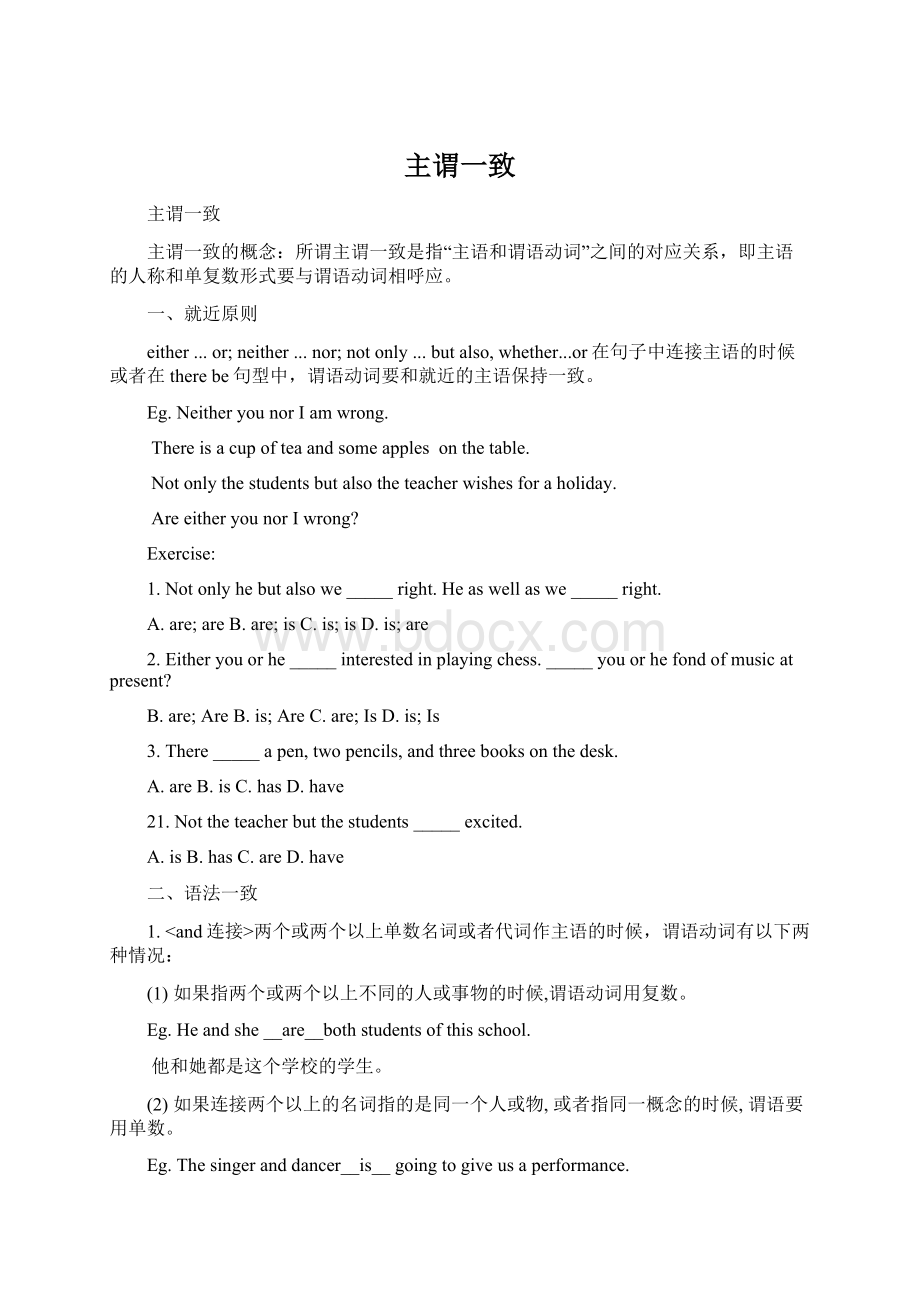主谓一致Word格式文档下载.docx
《主谓一致Word格式文档下载.docx》由会员分享,可在线阅读,更多相关《主谓一致Word格式文档下载.docx(8页珍藏版)》请在冰豆网上搜索。

AreB.is;
AreC.are;
IsD.is;
Is
3.There_____apen,twopencils,andthreebooksonthedesk.
A.areB.isC.hasD.have
21.Nottheteacherbutthestudents_____excited.
A.isB.hasC.areD.have
二、语法一致
1.
<
and连接>
两个或两个以上单数名词或者代词作主语的时候,谓语动词有以下两种情况:
(1)如果指两个或两个以上不同的人或事物的时候,谓语动词用复数。
Eg.Heandshe__are__bothstudentsofthisschool.
他和她都是这个学校的学生。
(2)如果连接两个以上的名词指的是同一个人或物,
或者指同一概念的时候,
谓语要用单数。
Eg.The
singer
dancer__is__
going
to
give
us
performance.
那个歌唱家兼舞蹈演员要给我们表演。
The
knife
fork
__is__on
刀叉在桌子上。
1.Aknifeandafork_____onthetable.Aknifeandfork_____onthetable.
A.is;
isB.are;
areC.are;
2.MyfriendandclassmatePaul_____motorcyclesinhissparetime.
A.raceB.racesC.isracedD.isracing
2.with,
along
with,
together
as
well
as,
besides,
like,
without,
except,
but,including
如果句子中有这些连接词和主语连用,谓语动词的数<
随主语的变化>
而变化。
teacher,
with
his
students,
planting
trees
in
street.
老师和他的学生们正在街道上植树。
1.NowTomtogetherwithhisclassmates_____footballontheplayground.
A.playB.areplayingC.playsD.isplaying
2.AllbutDick_____inClassThreethisterm.
A.areB.isC.wereD.was
3.Thefactory,includingitsmachinesandbuildings,_____burntlastnight.A.isB.areC.wereD.was
3.定语从句的<
关系代词who,
which,
that>
在从句中作主语时,要与<
先行词>
的人称和数保持一致。
Eg.Those
who
enjoy
singing
may
join
us.
Tom,
your
friend,
should
help
you.
Heisoneoftheboyswho_____hereontime.Heistheonlyoneoftheboyswho_____hereontime.
A.hascome;
havecomeB.havecome;
hascome
C.hascome;
hascomeD.havecome;
havecome
4.
如果主语是<
不定式,动词-ing形式或主语从句>
的时候,谓语动词一般用单数。
Eg.When
he
coming
seems
very
important.
他什么时候要来看起来很重要。
Collecting
stamps
hobby.
收集邮票是他的爱好。
To
love
her
break
wings.
爱她就不该折断她自由飞翔的翅膀。
1.Climbinghills_____ofgreathelptohealth.
A.isB.areC.wereD.Be
2.Tosee_____tobelieve.
A.areB.wereC.isD.be
3.HowandwhyJackcametoChina_____notknown.Whenandwheretobuildthenewlibrary_____notbeendecided.
hasB.are;
hasC.is;
haveD.are;
have
三、意义一致原则
所谓意义一致是指谓语动词和主语一致不是取决于主语的语法形式,而是其实际意义。
(有的主语名词在形式上是单数,
但在意义上却是复数;
有的主语名词在形式上是复数,
但在意义上却是单数。
)
(一)主语是不定代词或复合不定代词或被不定代词修饰时
1.不定代词all,
some,
any,
none作主语,谓语动词视情况而定。
Eg.All
__are__rotten.
所有的苹果都烂了。
All
apple
__is__rotten.
整个苹果都烂了。
None
money__is__
left.
没有剩下一点钱。
__is/are__
there.没有学生在那里。
2.不定代词each,
every,
no所修饰的名词<
即使以and或逗号连接成多主语时>
,谓语动词仍用单数形式。
every...
every
...;
each
no
在以上短语中and连接的单数名词,
整个短语在句中作主语时,
谓语动词常使用单数。
Eg.Each
boy
girl
wants
go
cinema.
Each
man
woman
asked
attend.
Every
class
diligent.
4 No
sound
voice
heard.
听不到任何声音。
1.Soonaftertheearthquake,everyman,womanandchild_____aboutit.
weretalkingB.wastalkingC.talkD.talks
2.Eachmanandeachwoman_____askedtohelpwhenthefirebrokeout.A.isB.wasC.areD.were
3.复合不定代词作主语,
谓语动词要用单数,如someone,somebody,something,anybody,anyone,anything,everybody,
everyone,
everything,nobody,no
one,nothing。
Eg.Someone
asking
有人找你。
Nothing
found
room.
在屋子里什么也没找到。
(二)指代意义决定谓语单复数
集体名词作主语,动词可用单数,也可以用复数。
主要由句子的意思决定。
强调整体谓语动词用单数;
指全体人员时,动词则用复数。
这一类常见的集合名词有public,
family,
class,
crowd,
population,
team,
group。
Eg.His
family
__is__agoodsampletofollow.
他们家是一个学习的好榜样。
His
__are__all
music
lovers.
他们全家人都是音乐爱好者。
注:
某些集体名词如people,
police,
cattle等,形式上是单数,但意义上是复数,谓语动词应用复数。
people指“民族”时是例外。
police
are
searching
thief.
cattle
eating
grass
hill.
Herfamily_____muchlargerthanminefouryearsago.Herfamily_____dancingandsingingwhenIcameinlastnight.
A.were;
wasB.was;
wereC.was;
wasD.were;
were
2.某些名词以s结尾如maths,
politics,
physics,
news,
plastics
等,谓语动词应用单数。
Eg.Physics
interesting
subject.
物理是一门很有趣的学科。
Plasticsisusedwidelynowadays.如今塑料被广泛运用。
3.
单复数同形的名词作主语时,依照意义一致的原则,表示单数意义时,谓语用单数;
反之,谓语用复数形式。
这一类名词有:
means(方法、手段),deer,fish,sheep,Chinese,Japanese,species(种类),works(工厂)
等。
Eg.Not
means
useful.
不是每种方法都好使。
all
不是所有的方法都好使。
(三)与后接名词或代词保持一致的情况
“分数或百分数+名词”构成的短语以及由“
lot
of,lots
of,plenty
of,a
large
quantity
heap
of,heaps
of,the
rest
of,half
of,part
of,majority
of+名词”构成的短语作主语时,其谓语动词要与短语中of
后面的名词的数保持一致,这是因为短语中后面的名词是中心词,而短语中前面的量词是修饰语。
Eg.Half
__have___finished
their
composition.
一半的学生已经完成了他们的作文。
Half
__is__bad.
一半的苹果坏了。
About
60
percent
our
school
__are__boys.
我们学校,
大约百分之六十的学生是男生.
Eg.Lots
damage
was
caused
by
fire.
About
three-fourths
earth’s
surface
covered
water.
Three-fifths
workers
here
women.
和这种情况类似的还有“a
number
+
名词复数”。
但是,“the
名词”的中心词却是number。
Eg.A
new
books
desk.
50.
1._____ofthelandinthatdistrict_____coveredwithtreesandgrass.
Twofifth;
isB.Twofifths;
areC.Twofifth;
areD.Twofifths;
is
2.About60percentofthestudents_____fromthesouth;
therestofthem_____fromthenorthandforeigncountries.
isB.is;
areD.are;
are
3.One-thirdofthearea_____coveredwithgreentrees.Aboutseventypercentofthetrees_____beenplanted.
are;
haveB.is;
has
4.Thenumberofteachersinourcollege_____greatlyincreasedlastterm.Anumberofteachersinthisschool_____fromthecountryside.
A.was;
isB.was;
areC.were;
areD.were;
5.What_____thepopulationofChina?
One-thirdofthepopulation_____workershere.
is;
areC.is;
isD.are;
2.如果主语有more
than
one(很多,非常)或many
a(许多)构成,one
half与单数名词组成的短语。
尽管从意义上看是复数内容,但它的谓语动词多用单数形式。
Eg.More
one
student
has
read
book.
Many
been
there.
seen
it.
但是,“more
+复数名词+than
one”结构之后,谓语动词一般多用复数形式。
members
against
plan.
Manyaprofessor_____lookingforwardtovisitingGermanynow.Manyscientists_____studiedanimalsandplantsinthelasttwoyears.
hasC.are;
haveD.is;
(四)一些有两个部分构成的名词表示衣物或工具作主语时,谓语动词通常用复数形式,例如:
glasses,
clothes,
trousers,
shoes,
compasses,
chopsticks,
scissors等。
但如果主语用“a
kind
of,
pair
series
of等加名词”构成时,谓语动词一般用单数形式。
(类似akindof等词的还有aportionof,apileof,apanel等,其引起主语时,谓语动词一般用单数)
shoes
worn
out.
这双鞋破了。
鞋子破了。
Apileoflotswassetbesidethehearth.炉边有一堆木柴。
(五)书刊名、时间、距离、价格、度量衡等的复数名词作主语时,
谓语动词常用单数。
Eg.Thirty
years
long
time.
Roots
famous
American
novel.
1.Twohundredandfiftypounds_____toounreasonableapriceforasecond-handcar.
A.isB.areC.wereD.Be
2.AsIhaveameetingatfour,tenminutes_____allthatIcansparetotalkwithyou.A.areB.wasC.isD.were
[注意事项]
1.this
book
=
this
(这种书)
其谓语用单数;
短语this
men
these
(口语)
(这一类人),但this
的谓语用单数,men
和these
的谓语用复数,all
kinds
后跟复数名词,谓语用复数形式。
Eg.This
dangerous.
Men
2.
在主谓倒装的句子中,谓语动词的数应与其后的主语一致。
Eg.Between
two
windows
hangs
picture.
3.a
great
deal
amount
of,a
(large)
of修饰不可数名词,其短语作主语时,谓语动词通常用单数;
amounts
of,quantities
修饰不可数名词,其短语作主语时,谓语动词通常用复数。
people
needed
here.
Quantities
food
(nuts)
were
table.
答案及部分解析:
1-5CBABC6-10BBACB11-15ADAAB
16-20DBBDA21-25CBCBD
1.“分数或百分数+ofthe+名词或代词”作主语时,谓语动词的单、复数形式取决于名词或代词的单、复数形式。
2.“thenumberof+名词”作主语,谓语动词常用单数形式。
“anumberof+名词”作主语,谓语动词常用复数形式。
3.“分数或百分数+ofthepopulation”作主语,谓语动词常用复数形式。
4.or,either...or,neither...nor,notonly...butalso等(关联)连词连接两个并列主语时,谓语动词的数按“就近原则”处理。
注意:
即使在疑问句中,动词的数也应与最近的主语保持一致。
aswellas连接两个并列主语时,谓语动词的数应与前一主语保持一致。
5.what引导的名词性从句作主语时,谓语动词常用单数形式。
但当作表语的名词为复数,或what从句是一个具有复数意义的并列结构时,谓语动词常用复数形式如:
WhatIsayandthinkarenobusinessofyours.
6.在“oneof+复数名词+定语从句”的结构中,定语从句中谓语动词常用复数;
在the(only)oneof+复数名词+定语从句”的结构中,定语从句中谓语动词常用单数。
8.manya+单数名词,morethanone+单数名词”作主语,尽管从意义上看是复数,但谓语常用单数形式。
9.通常情况下,由and或both,and连接两个单数形式的名词(词组)作主语时,谓语动词常用复数形式。
当并列主语在意义上指同一人、一物、同一事或同一概念时,谓语动词则常用单数形式。
10.第一句的herfamily应理解为“她的家庭”;
第二句中的herfamily应理解为“她一家人”。
12.当主语后有togetherwith,but,ratherthan,including等引导的词组时,谓语动词的数由主语的数来决定。
13.表示度量、时间等的复数名词作主语时,往往把其看作一个整体,谓语动词采用单数形式。
16.第一空前each作同位语,不影响谓语动词的数;
第二空each为主语部分的中心词,谓语动词应用单数形式。
18.Therebe句型中,谓语动词的数按“就近原则”处理。
20.非谓语动词短语作主语时,谓语动词常用单数形式。
21.